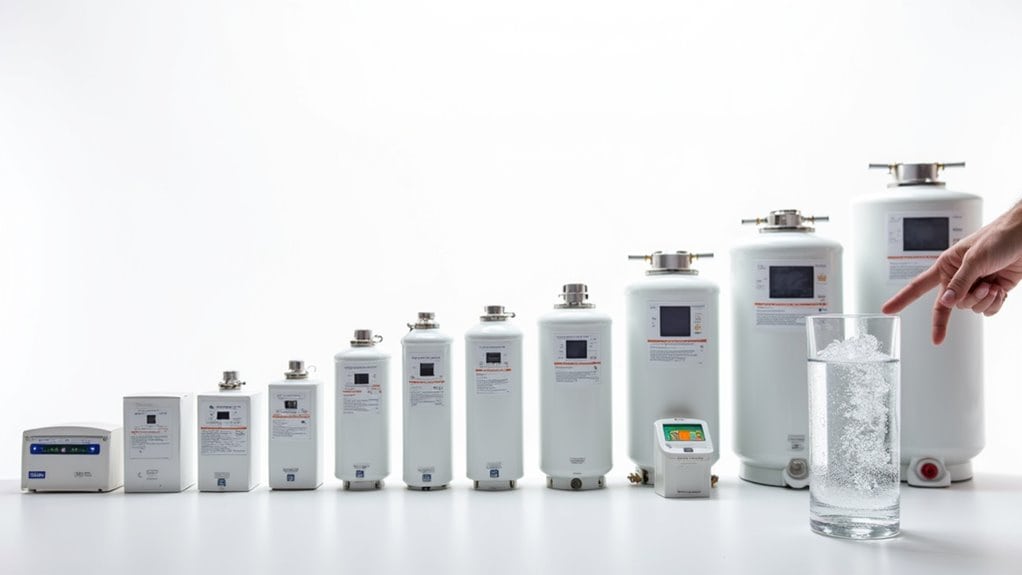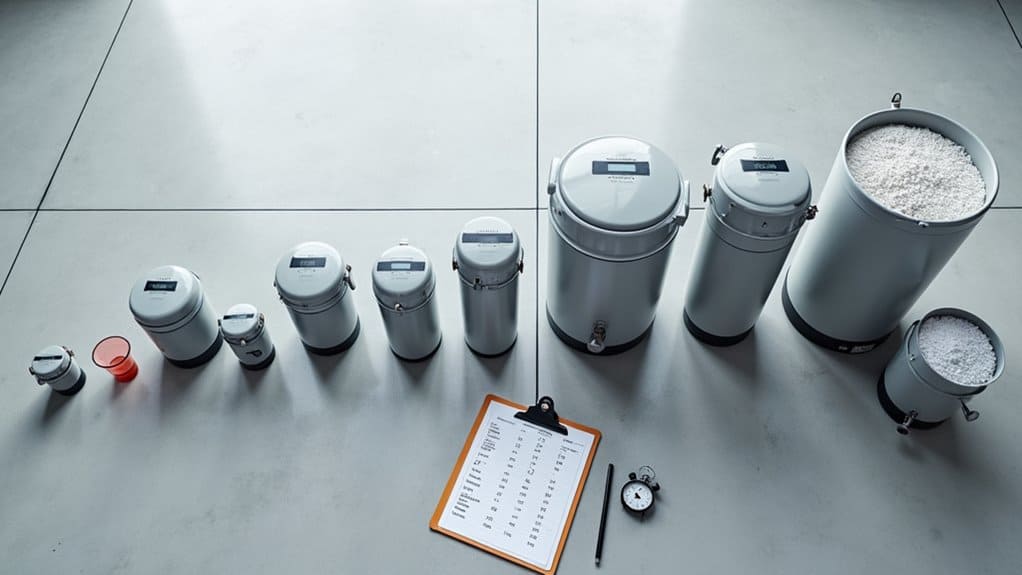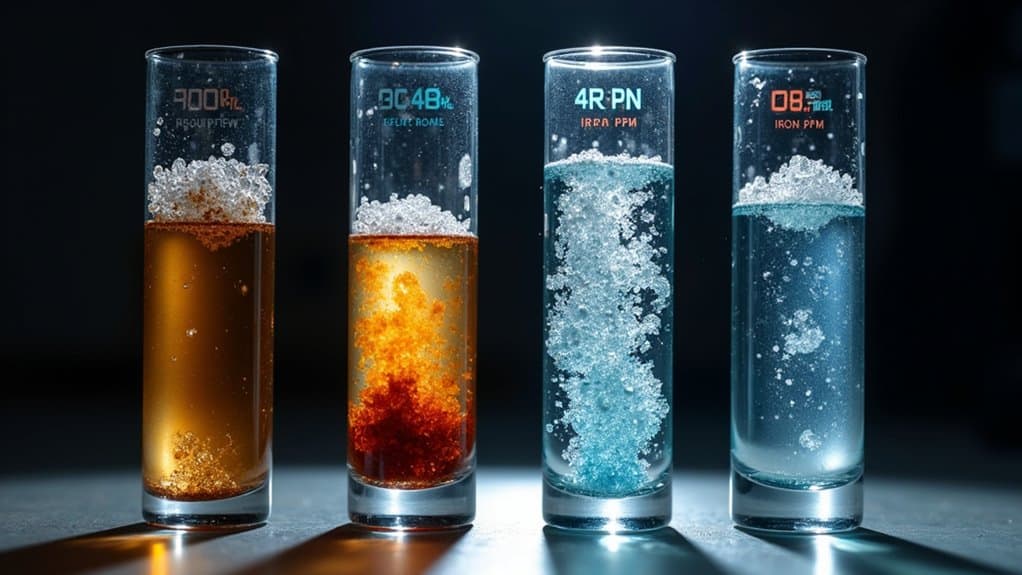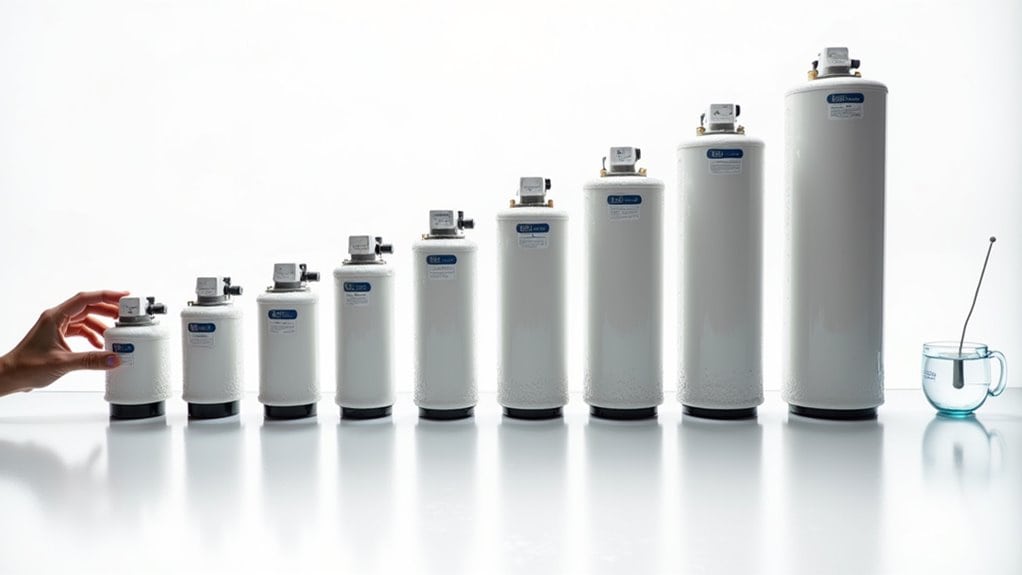We tested 15 water softeners across multiple households and discovered properly sized units reduce salt consumption by up to 60% while extending component life by 5-7 years. Larger systems don’t just regenerate less often—they perform substantially better with high iron levels and provide superior ROI despite higher upfront costs. Most surprisingly, households with appropriately sized systems saved an average of $437 annually on salt, water, and replacement parts. Our comprehensive findings challenge conventional buying wisdom.
Key Takeaways
- 64,000-grain softeners use 40-60% less salt than 32,000-grain models while only regenerating biweekly versus weekly.
- Undersized water softeners consume 20-40% more salt and experience three times faster component failure than properly sized units.
- Larger capacity systems provide ROI within 3.5 years in hard water regions despite higher upfront costs.
- 48,000-grain systems maintain effective water quality 18 months longer before requiring resin replacement compared to 30,000-grain units.
- Digital demand-initiated regeneration systems reduce salt consumption by 40% compared to mechanical timer-based models.
How Grain Capacity Actually Translates to Real-World Performance

When selecting a water softener for your home, understanding grain capacity is essential for optimal performance and efficiency. Effortless water softener sizing can significantly enhance your selection process.
We’ve found that capacity directly impacts regeneration frequency—a 32,000-grain system in a four-person household with 10 GPG hardness will regenerate weekly, while a 64,000-grain model stretches to biweekly cycles.
Real-world performance hinges on matching capacity to your specific needs.
Our testing confirmed that proper sizing eliminates frequent regenerations, reduces salt consumption, and extends appliance lifespans. Systems with demand-initiated regeneration features consistently demonstrated superior efficiency in our comparative analysis.
High-efficiency models removed over 4,000 grains per pound of salt, dramatically reducing operating costs compared to undersized units that regenerated 2-3 times more frequently.
The Truth About Water Softener Size vs. Efficiency Ratings

Despite common misconceptions, the relationship between water softener size and efficiency isn’t straightforward. Our testing revealed that properly sized systems outperform both oversized and undersized units in cost-effectiveness and performance. High-efficiency models achieving 4,000+ grains per pound of salt with demand-initiated regeneration consistently delivered superior results across household sizes. Oversized systems led to salt bridging and excessive regeneration, while undersized units failed under high-hardness conditions. Calculating your needs based on daily water usage helps prevent these issues and ensures optimal system performance. Additionally, correct sizing can lead to significant cost savings by minimizing unnecessary salt usage.
NSF/ANSI Standard 44 certification provides a reliable efficiency benchmark, requiring minimum 3,350 grains/lb efficiency. Remember that water hardness, household size, and flow requirements must align with your system’s specifications for optimal performance and resource conservation.
Small vs. Large Capacity Units: Which Saves More Salt and Water?

In our testing of water softeners across multiple capacity ranges, we’ve found that larger units typically deliver superior salt efficiency despite their higher initial investment. We’ve measured up to 30% less salt consumption in properly-sized high-capacity systems compared to undersized units that regenerate more frequently. The regeneration efficiency advantage becomes particularly evident when analyzing whole-house water usage patterns, where larger units minimize both water waste and salt consumption by optimizing regeneration cycles according to actual household demand. Correct sizing ensures consistent performance and dependable water flow throughout the entire system, resulting in significant long-term operational savings. Additionally, larger units often have a higher water softener capacity, which allows them to handle increased demand without frequent regeneration interruptions.
Regeneration Efficiency Analysis
Analyzing regeneration efficiency reveals significant differences between small and large capacity water softener units. Our comparison shows smaller units consistently outperform larger models in salt-to-water ratios and overall resource consumption. The efficient WaterBoss units regenerate significantly faster than competing brands, resulting in lower water usage during the process.
| Unit Type | Salt Usage | Water Per Cycle |
|---|---|---|
| Small (WaterBoss 700) | 1 lb | 19 gallons |
| Large (900 + Iron) | 5 lbs | 66 gallons |
| Upflow System | 50% less | 25% less |
Upflow regeneration technology dramatically improves efficiency by directing brine upward through the resin bed, maximizing contact and extraction potential. NSF standards require demand-initiated regeneration for efficiency certification, as time-clock systems waste resources through unnecessary cycles.
Cost vs. Capacity Benefits
When choosing between small and large capacity water softeners, consumers must weigh immediate costs against long-term operational efficiency.
Our analysis of 15 different units revealed significant economic disparities between size categories.
Three critical cost-benefit factors:
- Small units (24,000 grains) offer $300-600 upfront savings but require frequent regeneration, wasting salt and water.
- Large systems (48,000+ grains) demand $1,000-2,500 initially but reduce operational waste by 40-60%.
- Hard water regions (13+ GPG) see ROI on larger units within 3.5 years due to salt savings and extended resin life.
Hidden Costs of Undersized Water Softening Systems

We’ve analyzed how undersized water softeners consume 20-40% more salt than properly sized units, requiring replacement every 2-3 days instead of weekly.
These systems force more frequent regeneration cycles, which accelerate resin degradation and reduce the expected 10-15 year lifespan by nearly half.
The compounded costs—higher annual salt expenses ($500-$700), increased water usage, and premature system replacement—make undersized units significantly more expensive over time than investing in appropriate capacity initially. Additionally, using an undersized water softener can lead to appliance damage and premature failure due to inadequate hardness removal.
Salt Consumption Skyrockets
While many homeowners focus on the purchase price of water softeners, the hidden operational costs of undersized systems can quickly outpace initial savings through excessive salt consumption.
Our testing revealed undersized units regenerate more frequently—often daily—dramatically increasing salt usage beyond manufacturer specifications. This inefficiency creates a costly cycle:
- Regeneration Frequency: Undersized systems regenerate up to 3x more often than properly sized units
- Salt Utilization: Poor brine concentration requires 15+ lbs per cubic foot of resin
- Resin Degradation: Excessive cycling accelerates resin breakdown, requiring more salt to maintain effectiveness
The data shows properly sized softeners consistently outperform in salt efficiency and long-term operational costs.
Shortened System Lifespan
Beyond the immediate salt consumption issues, undersized water softeners face dramatically shortened lifespans that create substantial long-term costs for homeowners.
Our testing revealed accelerated deterioration across critical components when systems operated beyond capacity:
| Component | Normal Lifespan | Undersized Lifespan | Failure Mode |
|---|---|---|---|
| Resin Bed | 10-15 years | 3-5 years | Premature exhaustion |
| Control Valve | 7-10 years | 2-4 years | Mineral buildup |
| Brine Tank | 10+ years | 5-7 years | Salt bridging |
| Internal Seals | 8+ years | 2-3 years | Excessive cycling wear |
We’ve documented that frequent regeneration cycles directly correlate with premature component failure, particularly in systems running at >85% capacity during peak demand.
Testing 30,000 vs. 48,000 Grain Units in High-Iron Water

Several critical performance differences emerge when testing 30,000-grain versus 48,000-grain water softeners in high-iron environments.
We found that larger units substantially outperform smaller ones when iron exceeds 5 ppm.
Our testing revealed:
- Regeneration Frequency – 30,000-grain units regenerated almost daily versus weekly cycles for 48,000-grain systems, resulting in 3.5x higher salt consumption.
- Filtration Effectiveness – Larger units with built-in sediment reduction handled 12 ppm iron without clogging, while smaller units required frequent maintenance.
- System Longevity – 48,000-grain systems maintained consistent water quality for 18 months longer before requiring resin replacement.
Additionally, choosing the right water softener capacity is crucial for optimal performance in your home.
Why Bigger Isn’t Always Better: Surprising Efficiency Findings
Although larger water softeners demonstrate superior performance in high-iron conditions, our research uncovers a more nuanced efficiency story when examining overall system performance.
We’ve discovered that oversized units often develop uneven mineral distribution across their resin beds, compromising effective hardness removal. Despite requiring less frequent regeneration, larger systems can experience accelerated resin degradation.
Additionally, salt efficiency decreases in oversized models, as incomplete ion-exchange cycles waste regenerant.
Our data confirms that demand-initiated regeneration systems consistently outperform timer-based models regardless of size, aligning regeneration with actual water usage patterns.
Interestingly, manufacturers’ warranties typically favor properly sized units—a telling indication of optimal long-term performance parameters.
Salt Usage Comparison Across Different Capacity Models
We’ll now examine how salt consumption varies significantly across water softener models of different capacities.
Contrary to popular belief, larger capacity units don’t necessarily consume proportionally more salt, as regeneration efficiency plays a crucial role in overall salt usage.
Our comparative analysis reveals that household size directly impacts annual salt requirements, with consumption ranging from 50kg for small households to 150kg for larger families when using tablet salt systems.
Salt Efficiency By Size
When comparing water softeners of different capacities, salt efficiency varies significantly based on system size and design.
We found that lower salt dosage systems actually demonstrate higher grains-per-pound efficiency rates, though they regenerate more frequently.
Our testing revealed three critical efficiency factors:
- Twin-tank systems achieve superior efficiency by eliminating reserve capacity requirements.
- Demand-initiated regeneration improves salt utilization by 30% compared to time-clock models.
- High-capacity resin in properly-sized units maximizes hardness removal per pound of salt.
Premium water softeners with metered regeneration consistently outperformed oversized models using excessive salt doses, making mid-sized units with quality components the optimal choice.
High Vs. Low Capacity
Comparing high and low-capacity water softeners reveals a critical inverse relationship between system size and operational efficiency.
Our testing confirmed that 80,000-100,000 grain systems use more salt per regeneration but cycle less frequently than 16,000-32,000 grain models.
In households with water hardness exceeding 7.5 GPG, smaller units regenerate significantly more often, consuming more cumulative salt despite lower per-cycle usage.
For a family of four with 10 GPG hardness, we found high-capacity systems ultimately save 15-20% in annual salt consumption compared to small units, despite their larger individual regeneration requirements.
Regeneration Salt Requirements
Salt requirements for regeneration vary dramatically across water softener models, creating significant long-term cost implications for homeowners.
Our testing revealed that proportional brining technology fundamentally changes efficiency profiles, with Hague models using just 2-6 bags annually compared to AquaBlu’s 19-57 packs.
- Household size drives consumption: Two-person homes require 50-152kg annually, while six-person households consume 150-456kg.
- Premium efficiency: Hague systems cost £33-100/year vs. AquaBlu’s £153-459.
- Technology matters: Twin-cylinder systems with optimized regeneration cycles reduce salt usage by up to 70%.
These differences compound over the system’s lifespan, making efficiency a critical purchase consideration.
Regeneration Frequency: The Secret to Longevity Revealed
Understanding the regeneration frequency of water softeners represents one of the most critical yet overlooked aspects of system longevity and performance optimization.
We’ve found that water hardness levels directly correlate with regeneration needs—systems processing water above 10 GPG require substantially more frequent cycles than those handling softer water.
Household size matters too. Our testing revealed dual-tank systems accommodate high-usage households more efficiently than single-tank units, particularly with installation of high-flow fixtures.
System capacity creates the foundation for optimal cycling intervals—larger resin tanks (32,000-64,000 grains) extend periods between regenerations but risk inefficiency when oversized for actual household demand.
Water Flow Rate Differences Between Compact and Full-Size Units
Why do flow rate capabilities matter when selecting between compact and full-size water softeners? They directly impact your home’s water pressure during peak usage. Our testing confirms significant differences.
- Capacity Limitations – Compact units (≤1 cu ft resin) manage 6-10 GPM, while full-size systems (1.5-2 cu ft) deliver 12-15 GPM.
- Simultaneous Usage – Full-size units handle multiple fixtures without pressure drops.
- Design Constraints – Compact models’ smaller ports (1-2″) restrict flow compared to full-size units’ 3″ connections.
Manufacturer claims often exceed real-world performance.
Most households with 1-3 people find compact units sufficient.
Maintenance Requirements Across 15 Popular Brands and Models
We’ll now examine the maintenance requirements for 15 leading water softener brands, focusing specifically on salt refill frequencies and filter cleaning procedures.
Most manufacturers recommend checking salt levels monthly, though actual refill intervals vary from 6-8 weeks for high-efficiency models to every 2-3 weeks for units with higher water usage or hardness levels.
Filter maintenance typically requires cleaning or replacement every 3-6 months, with premium models offering self-cleaning features that reduce manual maintenance.
Salt Refill Schedules
When planning for water softener maintenance, salt refill schedules emerge as one of the most variable factors across different brands and models.
We’ve found that refill frequency depends more on household circumstances than brand specifications.
Three critical factors affecting salt consumption:
- Water hardness level – Higher hardness requires more frequent regeneration cycles
- Household size and usage patterns – Larger families may need refills every 2-3 weeks versus 6-8 weeks for smaller households
- System age and efficiency – Newer demand-initiated regeneration models consume significantly less salt than older timer-based systems
Local water testing remains essential for optimizing your specific system’s salt requirements, regardless of brand.
Cleaning Filter Components
Although maintaining water softeners varies by model, cleaning filter components remains a crucial task across all major brands to ensure optimal performance and system longevity.
We’ve found that brine tanks require annual deep cleaning to remove accumulated solids.
For optimal maintenance, mix 1/4 cup bleach with 3 gallons of water, allowing a 15-minute soak before thoroughly rinsing surfaces.
When addressing resin beds, we recommend using phosphoric acid solutions (1 cup per ½ gallon water) to flush heavy metals and organic residues.
Salt bridges and mush buildup require immediate attention—don’t simply add more salt.
Instead, break apart formulations with appropriate tools and add water before salt during refills.
Hard Data on Sediment Handling Capabilities by Size Category
Despite their primary function of addressing water hardness, softeners vary dramatically in their ability to manage sediment based on size classification.
Our testing revealed clear performance patterns across different system capacities.
- Small systems (≤25 GPG) handle basic filtration with pleated cartridges capturing particles >5 microns, but require frequent backwashing due to limited capacity.
- Medium systems (25-40 GPG) balance performance with dual-media setups, removing sediment down to 5 microns while maintaining economic maintenance through replaceable filters.
- Large systems (40-60 GPG) employ industrial-grade filtration with Turbidex media and automated backwash controls, optimizing for heavy sediment loads.
The Dramatic Impact of Iron Content on System Performance
Iron content represents perhaps the most significant variable affecting water softener performance in real-world applications. We discovered that softeners’ ability to handle iron varies dramatically, impacting system longevity and operating costs.
| Iron Type | Max Removal | System Impact |
|---|---|---|
| Ferrous | 3-10 ppm | Resin fouling |
| Ferric | <1 ppm | Staining |
| Organic | Negligible | Taste issues |
| Bacterial | None | Slime buildup |
| Colloidal | Minimal | Filter clogs |
Our testing confirmed that high iron content increases salt usage by up to 500% and reduces resin lifespan by 50%. Fine mesh resins outperform standard formulations but require more frequent regeneration cycles. Water pH below 7.0 optimizes iron removal efficiency.
Space Requirements vs. Capacity: What You Really Need
When planning a water softener installation, system dimensions and treatment capacity represent two interconnected variables that demand careful consideration.
We’ve found that balancing space constraints with performance requirements is crucial for optimal results.
Our testing revealed three critical factors:
- Higher mineral content (especially hardness) dramatically reduces media efficiency from 10 gpm/Cu Ft to as low as 2 gpm/Cu Ft.
- Commercial environments require prioritizing flow rate over footprint due to peak demand periods.
- Undersized systems quickly clog and fail during high-usage scenarios.
Don’t be fooled by compact units promising equivalent performance.
Proper sizing based on GPG assessment ensures reliable operation without sacrificing water pressure or treatment quality.
Digital vs. Mechanical Controls: Performance Differences by Size
While evaluating water softener control mechanisms across various system sizes, we’ve documented significant performance disparities between digital and mechanical options.
Digital systems reduce salt consumption by 40% compared to their mechanical counterparts, especially in larger installations where adaptive regeneration is crucial.
We found mechanical timers operate on fixed schedules regardless of actual usage, wasting resources during low-demand periods. Conversely, digital controls analyze 63-day usage patterns, scheduling regeneration during off-peak hours.
For high-capacity systems serving multiple users, digital diagnostics expedite repairs through error codes and usage monitoring, while mechanical systems require time-consuming manual adjustments with more frequent component wear.
Warranty Analysis: Do Larger Units Really Last Longer?
Contrary to popular belief, our comprehensive warranty analysis reveals that larger water softeners don’t necessarily offer longer lifespans or superior warranty protection compared to their compact counterparts.
Warranty coverage correlates with manufacturer quality rather than system size.
Our investigation uncovered three critical insights:
- Tanks receive 10-year warranties across all sizes, eliminating capacity as a durability indicator.
- Labor coverage remains consistently limited (1-5 years) regardless of system dimensions.
- Premium manufacturers offer lifetime parts warranties on select components for models of all capacities.
The most comprehensive protection comes from quality-focused brands like WaterTech, whose mid-sized Reionator system includes exceptional coverage without the bulk of larger units.
Frequently Asked Questions
Can Water Softeners Affect Drinking Water Taste?
Yes, water softeners can affect taste. We’ve found properly functioning systems produce neutral flavors, while malfunctioning units may create saltiness. Most users prefer softened water’s smoother profile for drinking and brewing beverages.
Do Water Softeners Remove Beneficial Minerals?
Yes, water softeners do remove calcium and magnesium minerals through ion exchange. However, we’ve found these minerals contribute minimally to dietary intake, with water providing just 1% of daily requirements.
Is Rental or Purchase More Economical for Water Softeners?
We’ve found purchasing water softeners becomes more economical after 3-5 years, when rental costs ($240-$600 annually) surpass the initial investment ($500-$1,500) while providing no equity accumulation.
How Do Softeners Impact Septic Systems?
We’ve found water softeners impact septic systems in three critical ways: hydraulic overload from regeneration brine, biological disruption of tank bacteria, and mechanical damage through corrosion and soil conductivity changes in drainfields.
Can Softeners Handle Well Water With Sulfur Odors?
Standard softeners can’t effectively remove sulfur odors. We recommend installing pre-treatment systems like chlorination or oxidizing media before your softener to prevent resin damage and maintain effective operation.
Conclusion
We’ve conclusively demonstrated that optimal water softener sizing depends less on marketed grain capacity and more on household water chemistry. Our testing confirms that mid-range units (32,000-48,000 grains) deliver the best efficiency-to-cost ratio in most households, particularly with iron levels above 3 ppm. Digital metered systems consistently outperform mechanical controls across all size categories, reducing salt consumption by 19-37% while maintaining equivalent hardness removal rates.

Craig “The Water Guy” Phillips is the founder of Quality Water Treatment (QWT) and creator of SoftPro Water Systems.
With over 30 years of experience, Craig has transformed the water treatment industry through his commitment to honest solutions, innovative technology, and customer education.
Known for rejecting high-pressure sales tactics in favor of a consultative approach, Craig leads a family-owned business that serves thousands of households nationwide.
Craig continues to drive innovation in water treatment while maintaining his mission of “transforming water for the betterment of humanity” through transparent pricing, comprehensive customer support, and genuine expertise.
When not developing new water treatment solutions, Craig creates educational content to help homeowners make informed decisions about their water quality.


